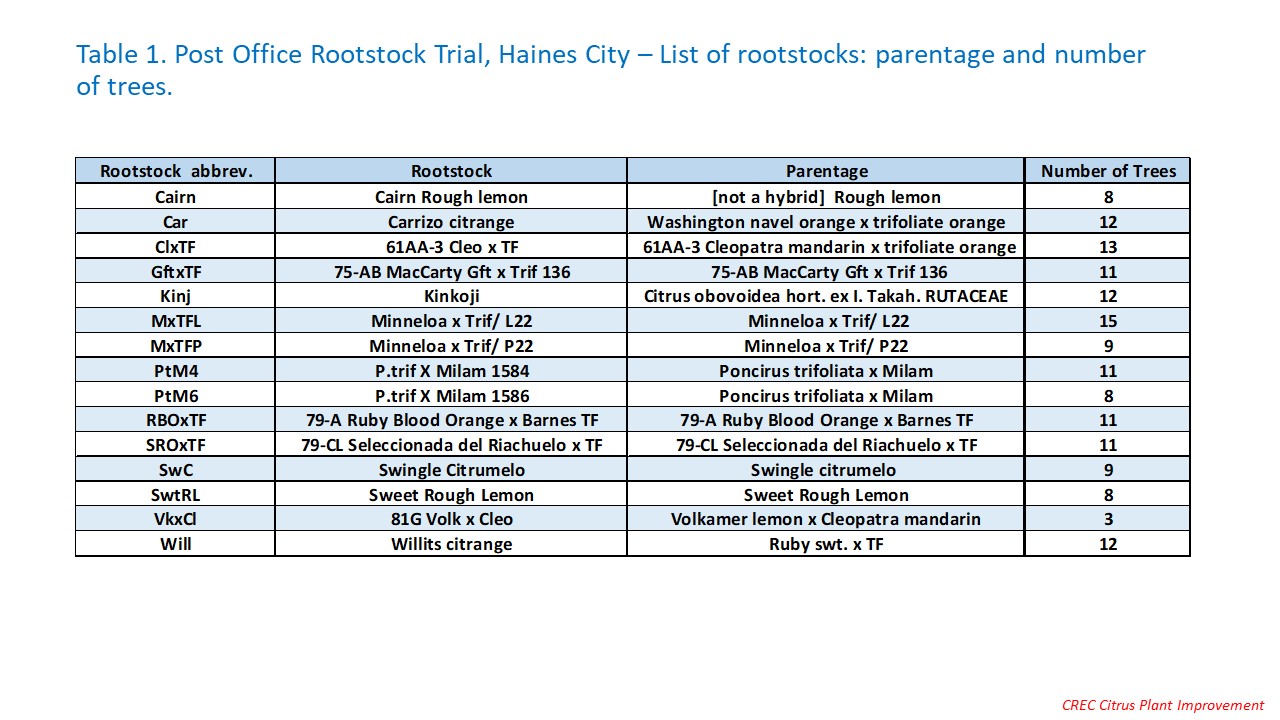Post Office Rootstock Trial, Haines City
Dr. Bill Castle – Dr. Fred Gmitter – Dr. Jude Grosser
July 6, 2021 – Updated
June 16, 2020 - Posted
CREC Citrus Plant Improvement
Post Office Rootstock Trial, Haines City Description
In this trial with two selections of Vernia midseason orange scion, the primary purpose was to evaluate a series of best-performing rootstocks created in Argentina by Jose Luis Foguet and selected from among a series of trials conducted in Argentina [Table 1].
The Post Office trial also included two rootstock hybrids, PTM 1584 and PTM 1586 produced by Dr. Harry Ford, CREC, in an attempt to combine citrus and burrowing nematode tolerance into a single rootstock. Tree size and HLB tolerance were additional considerations, thus, Willits citrange was included as a comparison for smallish tree size.
Post Office Rootstock Trial, Haines City - Summary
- Location: Haines City, Polk County
- Scion: Vernia
- Rootstocks: 15 [12 + Swingle citrumelo, Carrizo citrange and Kinkoji]
- Date Planted: 2003
- Design:
- Randomized complete-block
- Replications: 6
- Plot size: 2 trees for each scion/rootstock combination
- Spacing: 15 x 23 ft. = 134 trees/acre
- Data:
- 2015/16: Tree health, height ratings and yield [boxes/tree]
- 2017/18 : Yield [boxes/tree]
- 2018/19: Juice quality, yield [boxes/tree] and PS/acre
- 3-year cumulative yield: 2015/16, 2017/18 and 2018/19 seasons
- Trial status: INACTIVE [Spring 2021]
Post Office Rootstock Trial, Haines City – Interpretive Summary as of June 2021:
Limited data were obtained from this trial after planting in 2003 with Vernia scion on rootstocks from Argentina and 3 Florida commercial standards in a design with 6 reps of 2-tree plots.
Tree ht. At age 12 years, the trees on the more vigorous rootstocks like rough lemon and Cleopatra mandarin hybrids were mostly 10 ft. tall while the smaller trees were <8 ft. tall like those of Willits citrange.
HLB. Visible leaf symptoms were present among all trees with little apparent effect on tree performance.
Yield. Yield was measured in only three seasons. When the 3-year cumulative yield was compared with tree height [Fig. 7, 8], the best performers were those on PTM 1584 and Sweet RL, i.e., they had relatively high yields despite tree size. The correlation of those two variables was 0.53 indicating that a relationship existed, but considerable variability was not accounted for by those two factors.
Juice quality. Fruit samples were collected in the 2018/19 season in February. Brix values ranged from 10-13 [Fig. 9] which were high values in comparison to other trials conducted during the HLB era.
PS/acre. When combining juice quality with yield, the top performing rootstocks in the 2018/19 season were PTM 1584, Kinkoji and the Argentine selection, 79 CL.
Rootstocks. Insufficient data are available to support any firm conclusions after 18 years, but the limited results suggest that no tested rootstocks should be considered poor performers. Some evidence is presented indicating that the smaller tree size of those on Willits citrange merit further evaluation of that rootstock as well as PTM 1584 which has done well in other trials. It is also noteworthy that selections of the old Florida rootstock, rough lemon, performed well.

.jpg)
